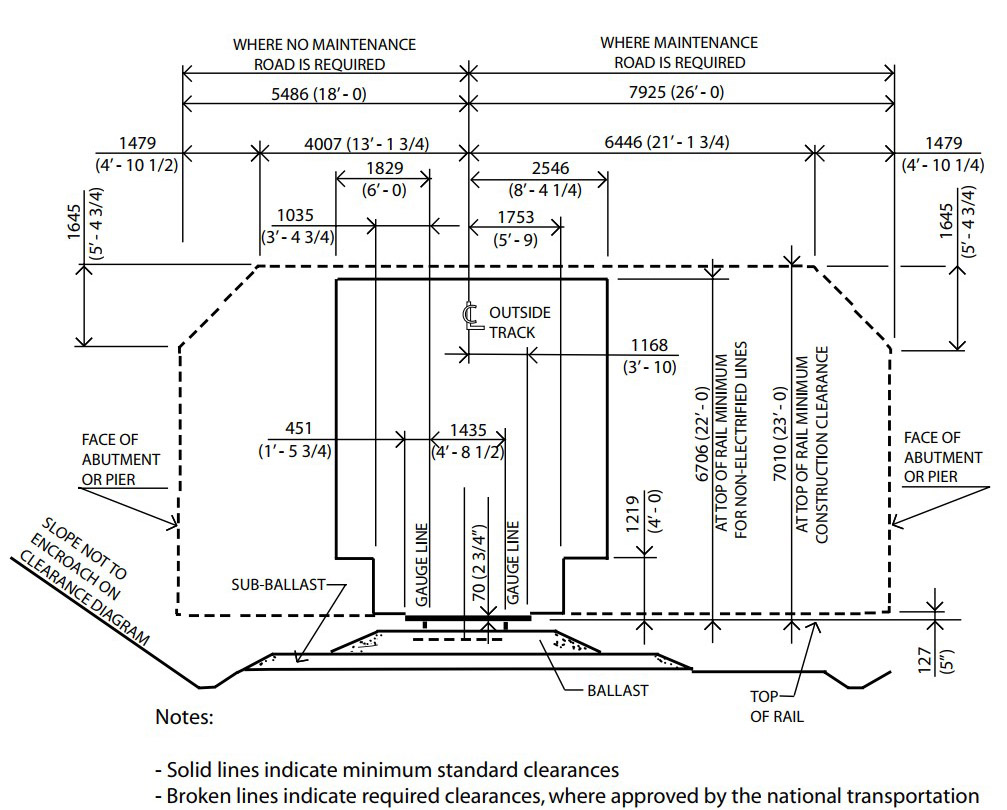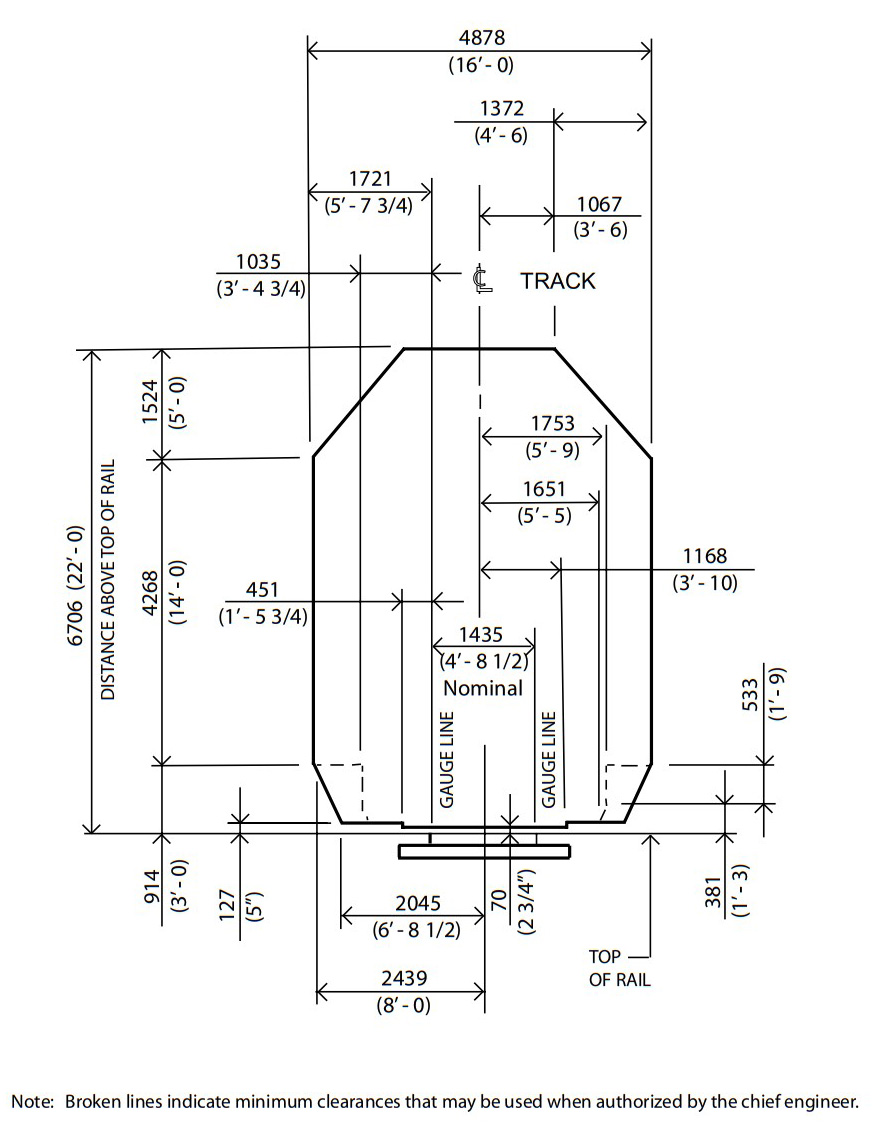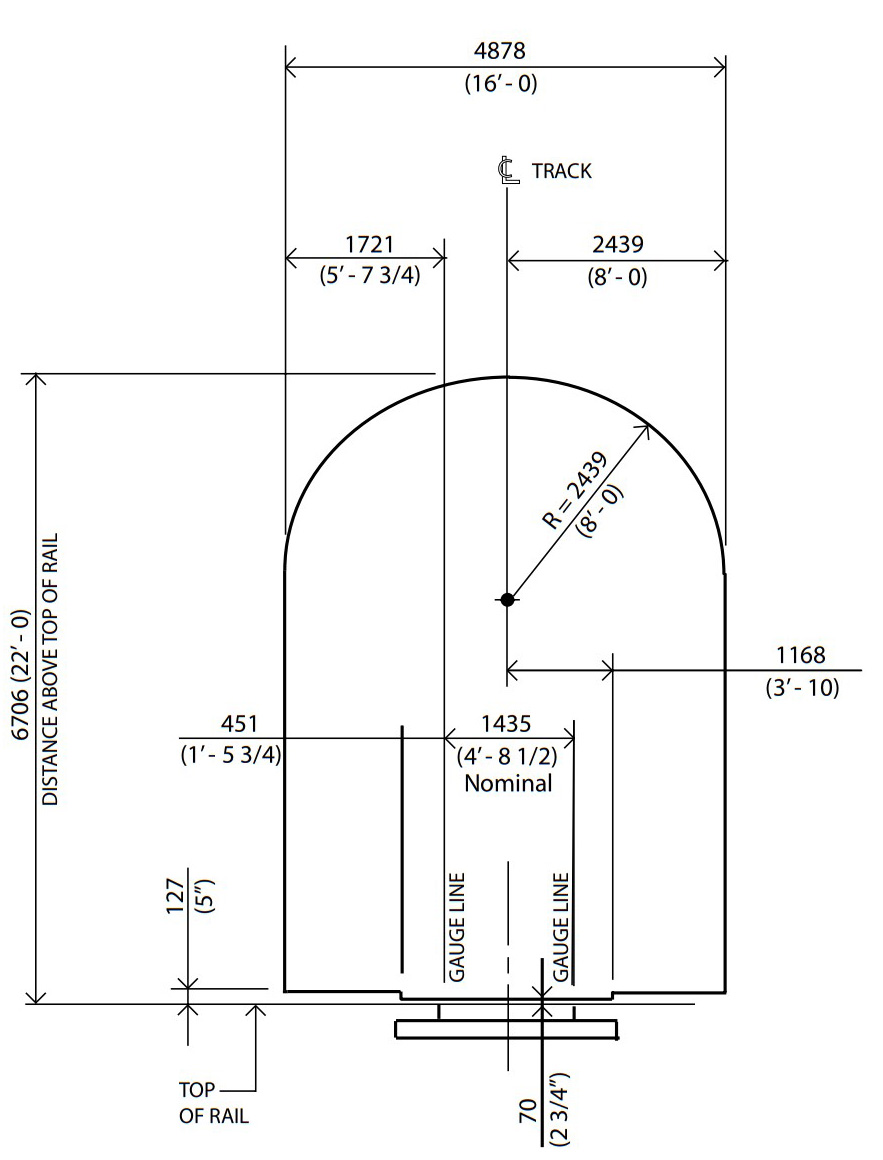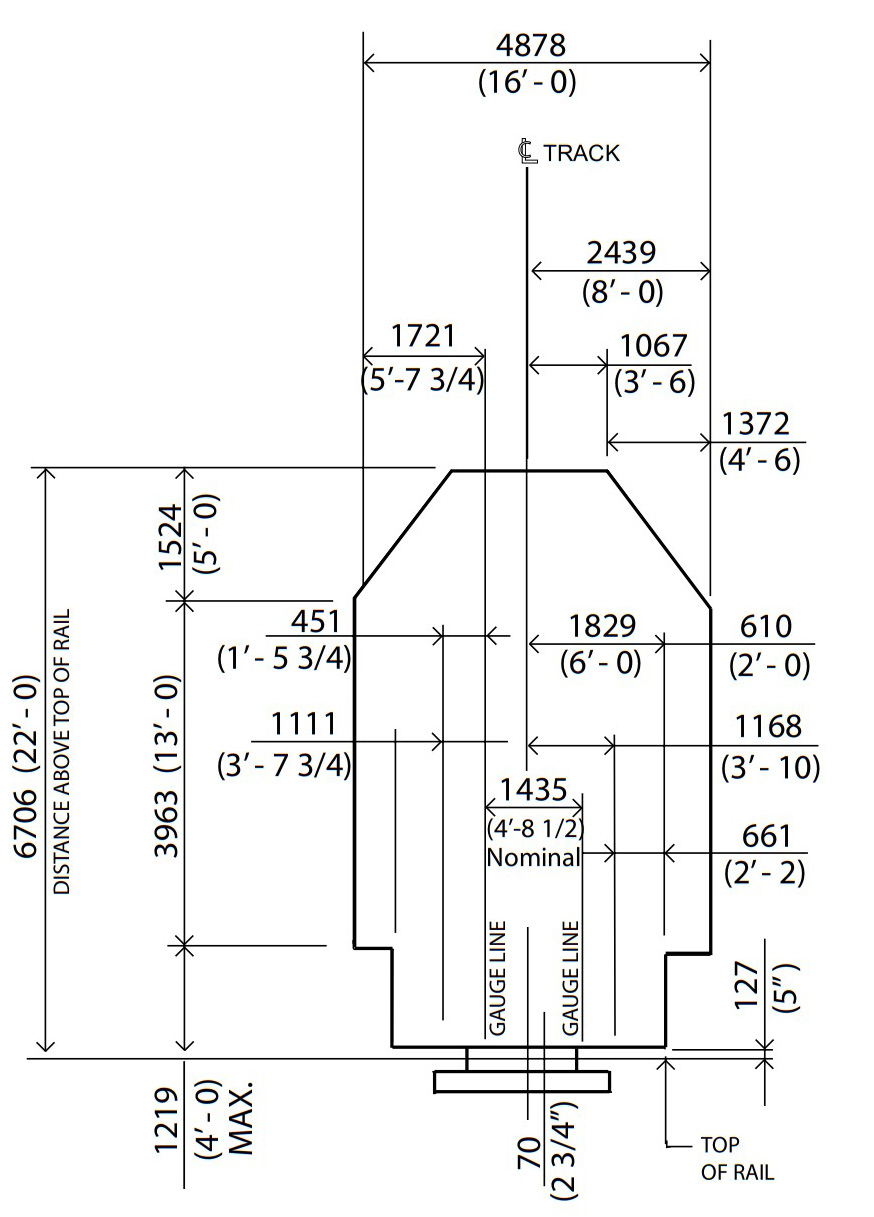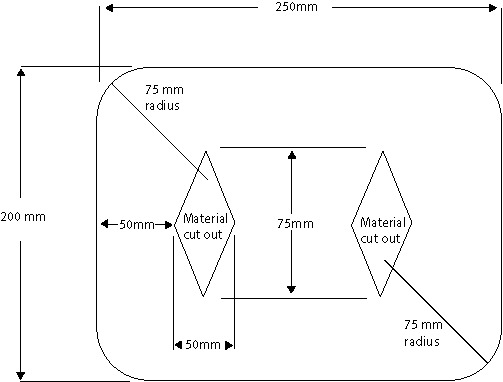Standards Respecting Railway Clearance
(PDF, 543 KB)
TC E-05, May 14, 1992
Table of contents
- Application of Standard
- Interpretation
- Standard Clearances
- Less than Standard Clearances
- Track Centres
- Siding Agreements
- Wires and Conductors
- Notifying the Minister of Transport
Appendix
1. Application of Standard
1.1 This Standard shall apply on all tracks owned or operated on by a railway company.
2. Interpretation
2.1 In this Standard: "Chief Engineer" means a person occupying the position of Chief Engineer, or in companies not having a Chief Engineer the senior official designated for this purpose.
3. Standard Clearances
Subject to section 4:
3.1
- every structure over or beside a railway track, except those structures governed by paragraphs (b), (c) and (d) below, shall afford the minimum clearances set out in Diagram 1;
- all railway bridges, snowsheds and overhead timber bridges shall afford the minimum clearances as set out in Diagram 2;
- all railway tunnels shall afford the minimum clearances as set out in Diagram 3;
- industrial sidings shall afford the minimum clearances as set out in Diagram 4, where required to be different to those set out in Diagram 1;
- a lateral allowance for track curvature of 25.4 mm (1 inch) per degree shall be provided;
- all clearance diagrams shall be perpendicular to the plane of the top of rails.
4. Less than Standard Clearances
4.1 All existing structures, bridges, snowsheds, overhead timber bridges and tunnels which met previous clearance requirements, but encroach within the clearance limits prescribed herein, shall not be considered as having less than standard clearances and shall be permitted to remain until the restrictive feature is modified or replaced.
4.2 Clearances not meeting the requirements of section 3 above, are permitted in the following circumstances:
- on a track at a main shop, diesel or car shop;
- doorways in buildings;
- ramps, platforms and similar structures to facilitate loading, unloading, servicing and maintenance;
- permanent structures to provide for or support locomotive and car wash facilities;
- temporary restrictions necessary to facilitate construction or repair of overhead structures, in which case the train crews are to be notified.
4.3
- Where circumstances do not permit the standard clearances prescribed in section 3.1, exceptions may be authorized by the Chief Engineer.
- Modifications may be made to clearances covered in subsection 4.1 and subsection 4.2 paragraphs (a), (d) and (e) upon approval of the Chief Engineer.
- The construction of a structure creating less than standard clearances shall not begin until approved by the Chief Engineer.
4.4 At locations described in subsection 4.2 paragraphs (b) and (c) and where the Chief Engineer has approved a less than standard clearance pursuant to sections 3.1 and 4.3, a less than standard clearance sign, as shown in Appendix "A", shall be erected and maintained adjacent to the track on which the restriction is located and at an adequate distance from the restriction. Where physical impediments preclude the erection of such a sign, the less than standard clearance will be identified in special instructions.
4.5 Requests for approval of less than standard clearances shall be submitted to the Chief Engineer and shall include the following information:
- reasons for less than standard clearance;
- if operations over the trackage concerned will be by locomotive, car puller or gravity;
- if locomotives will pass the point of less than standard clearance;
- type of cars that will pass the point of less than standard clearance;
- confirmation that trackage cannot be realigned to avoid the less than standard clearance or that the restricting object cannot be placed where it would no longer represent a restriction;
- if the less than standard clearance will be permanent or temporary;
- a drawing showing the relative position of the trackage and the obstruction, with cross sections at each point of less than standard clearance indicating the vertical clearance from the top of rail and the horizontal clearance from the centre line of the track, together with the location of the less than standard clearance sign.
4.6 Employees must not ride the side or above the roof of a moving engine or car when passing side and/or overhead restrictions.
5. Track Centres
5.1 Subject to subsection 5.2, all trackage built or rearranged after the coming into force of this Standard shall, comply with the minimum distances between track centre lines with due allowance for superelevation and curvature and shall be as follows:
- Main tracks 3.96 m (13 feet)
- Main and siding tracks 4.27 m (14 feet)
- Main or running tracks and parallel yard tracks 4.27 m (14 feet)
- Yard tracks 4.11 m (13 feet, 6 inches)
- Ladder and other tracks 4.57 m (15 feet)
- Parallel ladder tracks 5.49 m (18 feet)
- Freight shed tracks 3.66 m (12 feet)
- Team tracks in pairs 3.66 m (12 feet)
- Passenger station tracks without platform between 3.96 m (13 feet)
5.2
- Where circumstances do not permit the track centres prescribed in subsection 5.1, exceptions may be authorized by the Chief Engineer.
- The construction of tracks with less than minimum distances, as provided for in subsection 5.2 paragraph (a), shall not begin until approved by the Chief Engineer.
5.3 The minimum distance between track centre lines shall be increased to account for curvature and superelevation as follows:
- 50.8 mm (2 inches) per degree of curvature of track;
- where the curve elevation of the outer track exceeds the elevation of an adjacent inner track, an additional 63.5 mm (2-1/2 inches) per 25.4 mm (1 inch) of difference in curve elevations between the adjacent tracks.
6. Siding Agreements
6.1 Siding agreements shall contain a clause setting out the requirements of this Standard.
7. Wires and Conductors
7.1 Canadian Standards Association Standard C22.3 shall be used for minimum clearances.
8. Notifying the Minister of Transport
8.1 The Minister of Transport will be notified, in writing, of:
- clearances pursuant to subsection 4.2 paragraphs (b) and (c) and subsection 4.3 paragraph (a);
- deviations of track centres specified in subsection 5.1 paragraphs (a), (b) and (c).
Diagram 1: All Structures Over or Beside the Railway Tracks (Scale 1:75)
Notes:
- Solid lines indicate minimum standard clearances
- Broken lines indicate required clearances, where approved by the national transportation
Diagram 2: All Railway Bridges, Snowsheds and Overhead Timber Bridges (Scale 1:75)
Note: Broken lines indicate minimum clearances that may be used when authorized by the chief engineer.
Diagram 3: All Railway Tunnels (Scale 1:75)
Diagram 4: Industrial Sidings (Scale 1:75)
Appendix A: Standard Restricted Clearance Sign
Possible Methods of Erecting Sign
Elevation of Sign
- Reflecting Material Specifications: 62-GP-11M
- Reflectivity: Level 1
- Sheeting Material: Reflective yellow sheeting to cover the entire surface
